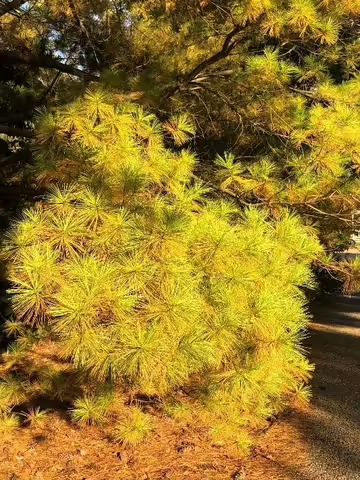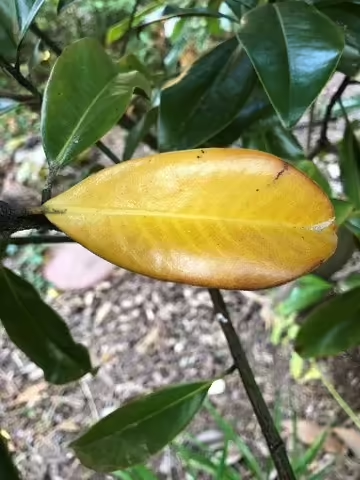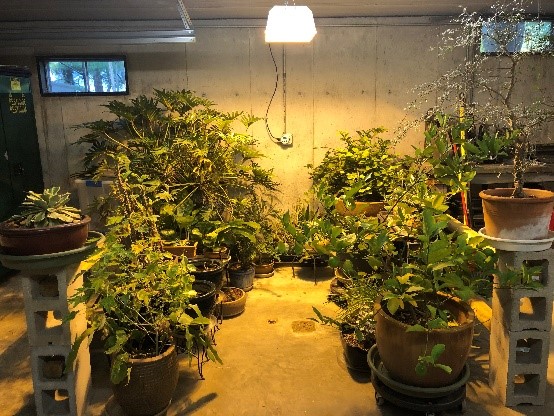It’s that time of year when eastern white pines (Pinus strobus) start dropping older needles, resulting in a new layer of sound-cancelling padding under trees. The sight of so many browning needles can be alarming though if you are not wise to the true meaning of evergreen. In general, evergreen refers to plants whose leaves (broadleaf, needle-like, scale-like or awl-like) last more than one year before falling. Deciduous plants on the other hand drop all of their leaves, leaving the plant completely devoid of leaves for part of the year. Naturally there are exceptions to my definition of deciduous, like in the case of marcescent leaves, which are leaves that have died but fail to abscise (drop) from the tree in a timely manner. This is common in oak (Quercus), beech (Fagus), hornbeam (Carpinus) and Persian ironwood (Parrotia), especially in younger trees.
With evergreens though, how long leaves live and the timing of leaf drop is all very species dependent. In the case of eastern white pine, new needles in groups of five are added every year and live for two years, creating an overlap between green needles at the tip and those further back that are due to drop starting in early fall. Southern magnolia (Magnolia grandifolia) on the other hand drops its oldest leaves in the spring simultaneously with expansion of new growth. Let’s just say, there is no sneaking up on someone if you have to walk through a layer of dropped magnolia leaves. They are thick, crunchy and take forever figuratively to breakdown.
I just recently heard mention of “bee lawns.” I was intrigued. Turns out a bee lawn refers to a lawn that includes flowering plants as well as turf grasses. For those of us who don’t control clovers, violets, dandelions and other flowering lawn weeds, technically we already have a bee lawn of sorts. The down side is broadleaves in a lawn are oftentimes viewed negatively and a sign of poor lawn care, especially if they escape into the neighbor’s beautiful yard of immaculate emerald. This narrative needs to change though to a focus on the benefits of a diverse species lawn, like how an increase in plant diversity benefits pollinators and other insects, plus the beauty of the flowers themselves. And anytime you increase plant diversity, you also potentially increase lawn resiliency to environmental stresses, which means less inputs potentially. Some weeds just don’t play nice though, choking out all other plants in an effort towards world domination. We need to find plants that aren’t as aggressive, but still do well in a lawn setting. Turns out someone has started this type of research. I found University of Minnesota has created a bee lawn toolkit (free online as a pdf download) for their growing region, based on a collaborative research project to identify which low-growing flowering plants could sustain growth within turf and continue to flower after mowing. It got me kind of excited about trying something similar in a trial section of my own lawn. Minnesota is quite a ways north of St Louis, so my first trial will include a seed mix of the plants they selected to see if they will survive our harsh St Louis summers. The Minnesota mix includes a number of fine fescues, ground plum, Dutch white clover, self-heal and creeping thyme. I’ve got the seed and plan to do a fall planting. Update to come.
Well, the Jungle experienced its first light frost of the season on October 5 about a week earlier than expected, meaning I was hustling the night before getting tender plants in the garage, saucers underneath and lights set up. Nothing like checking the weather at 5pm only to discover a frost is predicted the next morning! It’s all good. My ‘Meyer’ lemon tree has half a dozen fruit, so I know a nice lemon desert is in my future. I also I have not heard any tree frogs chirping from amongst the plants, which is always a worry. I don’t even mind that the temperature scooted right back up to “above average.” The plants are in for the winter and I can cross that task off my to-do list.


